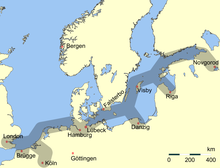Gotenhof (Novgorod)
The Gotenhof , also Warägerhof , (Latin Curia gotensium , Swedish Gutagård , Russian Готский двор ) was a settlement of Gotland merchants in Novgorod from the 11th to the 16th century.
location
The Gotenhof was in Novgorod on the trading side, east of the Volkhov, south of the Yaroslav court .
history
In the middle of the 10th century, the new Novgorod settlement was built near the Holmgard Castle . This was mainly used by dealers. During this period, trade with the Rus ran mainly from Novgorod to Visby ( Gotland ) to Western Europe.
In 1015 a merchant's yard was first mentioned in Novgorod . Around 1100 a man was mentioned on a rune stone in Sweden who had died (buried?) In the Olav Church in Novgorod. The Gotenhof must have existed by this time at the latest. The church burned down for the first time in 1152.
The Gotenhof has also been used by German traders since the 12th century. In 1192 the Peterhof was founded as a separate branch for them.
In 1217 the Gotenhof was almost completely destroyed by fire. The Gotenhof was first mentioned with this name in 1229. A Gotland guild yard was also mentioned in 1269.
In the 14th century, the importance of the Gotenhof declined after armed conflicts between German and Gotland merchants in Visby. The Gotenhof was leased by the Hanseatic League. This now had the monopoly in trade with Novgorod.
In the 15th century, Novgorod increasingly lost its importance to Riga and Reval in the Baltic Sea trade . 1494 had Ivan III. close the Peterhof. In 1514 Peterhof and Gotenhof were reopened. In 1562 the Gotenhof was probably still in use.
In the 17th century, the Schwedenhof was founded near the former Gotenhof.
literature
- Рыбина, Елена Александровна: Иноземные дворы в Новгороде XII-XVII вв. Moscow 1986 ( page no longer available , search in web archives: online )
- Рыбина Н. А .: Готский раскоп. In: Археол. изучение Новгорода. Moscow 1978
- Omeljan Pritsak : The origins of Rus. Cambridge (Mass.) 1981 ISBN 0-674-64465-4
- Norbert Angermann: The Hanseatic trade with Novgorod according to archaeological sources. Report on a Soviet publication. In: Hansische Geschichtsblätter 98 (1980), pp. 76-84
Remarks
- ↑ "Varägerkirche on the trading side" (варяжская [церковь] на Търговищи), First Novgorod Chronicle , cf. Pritsak 371.
- ^ First Novgorod Chronicle , cf. Pritsak 371.
- ↑ "Curia gotensium cum ecclesia et cimiterium Sancti Olavi" German in a contract merchants with Novgorod, see. Pritsak 371.
- ^ LK Goetz: German-Russian trade agreements of the Middle Ages. Hamburg 1916, pp. 86, 159 f.
Coordinates: 58 ° 31 ′ 0.5 ″ N , 31 ° 17 ′ 7.1 ″ E

